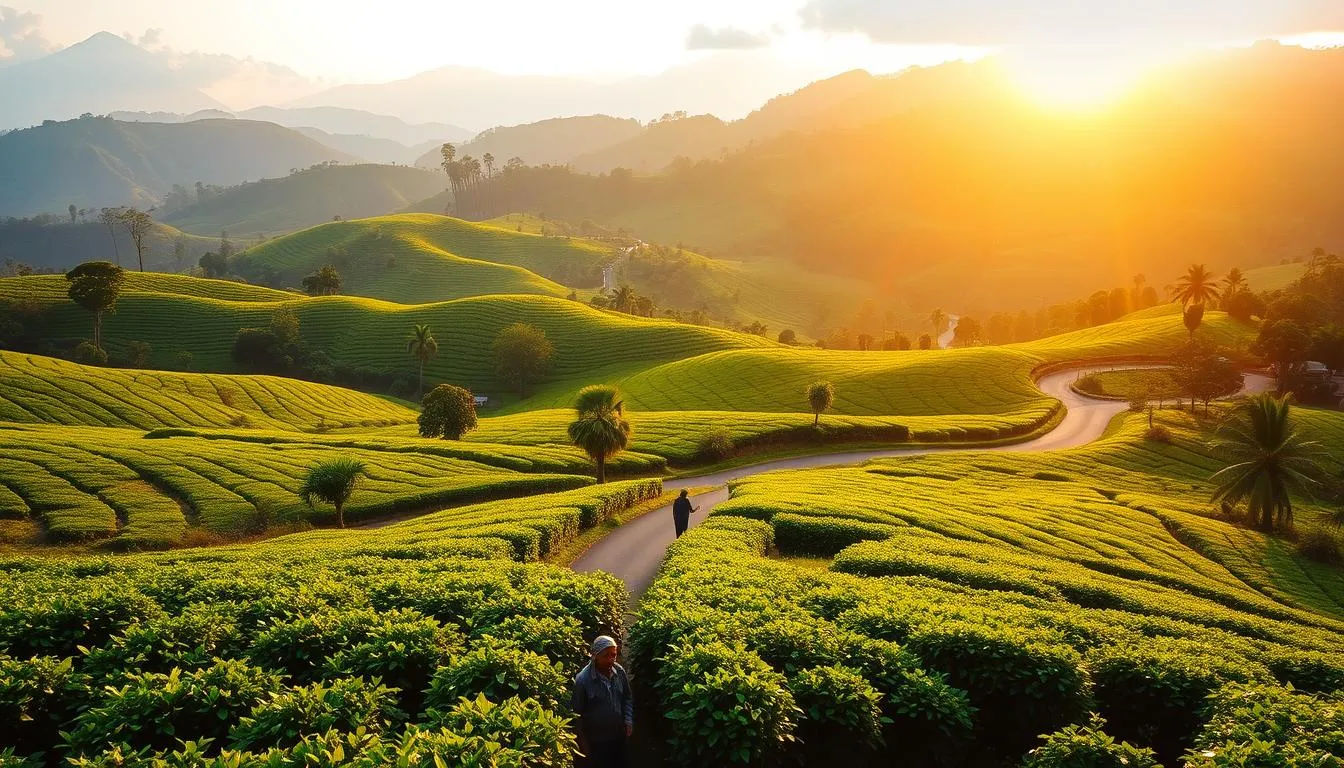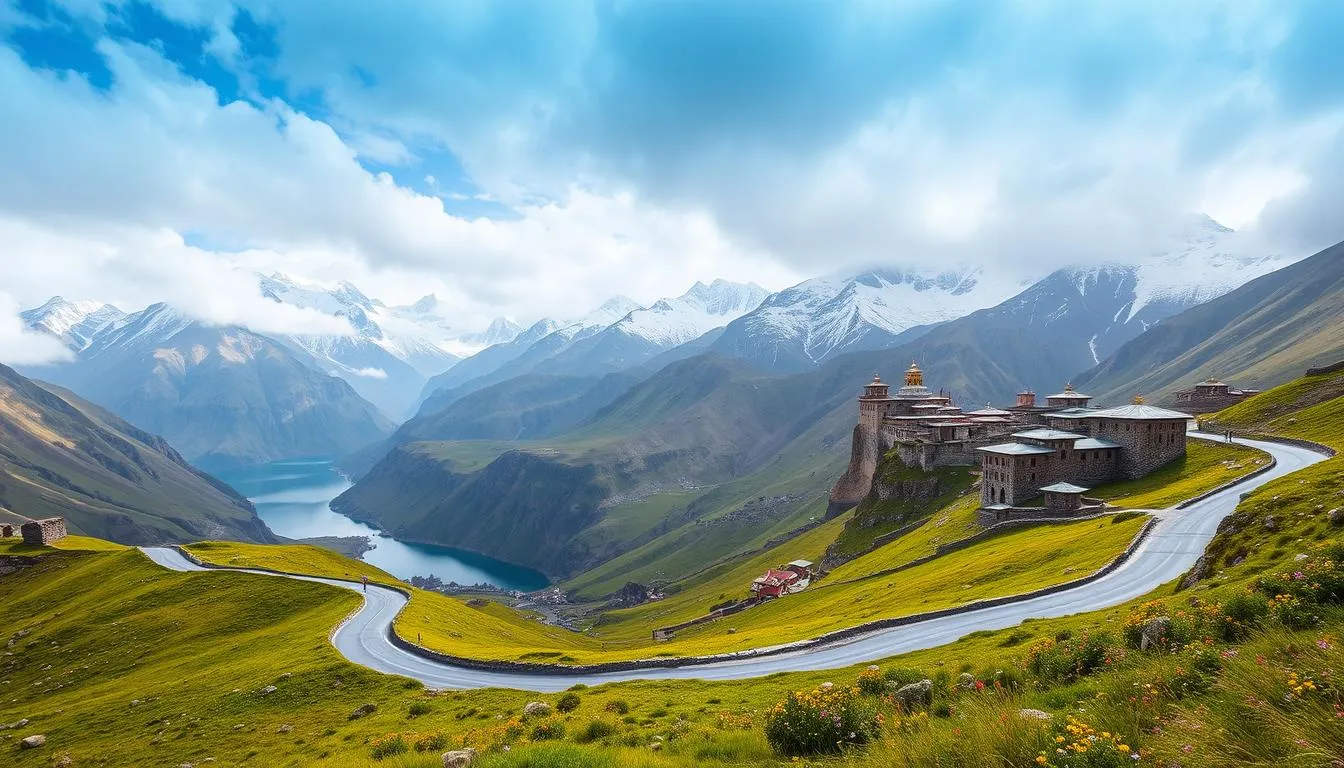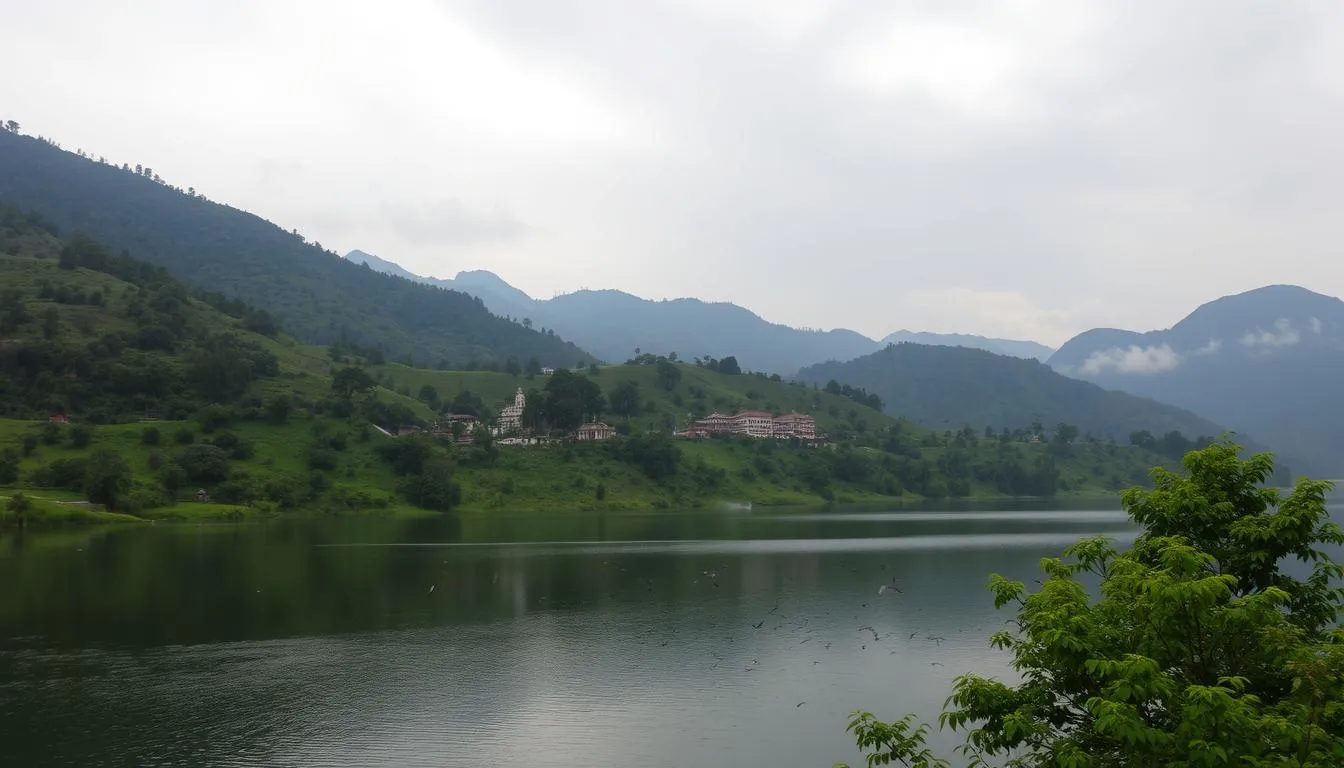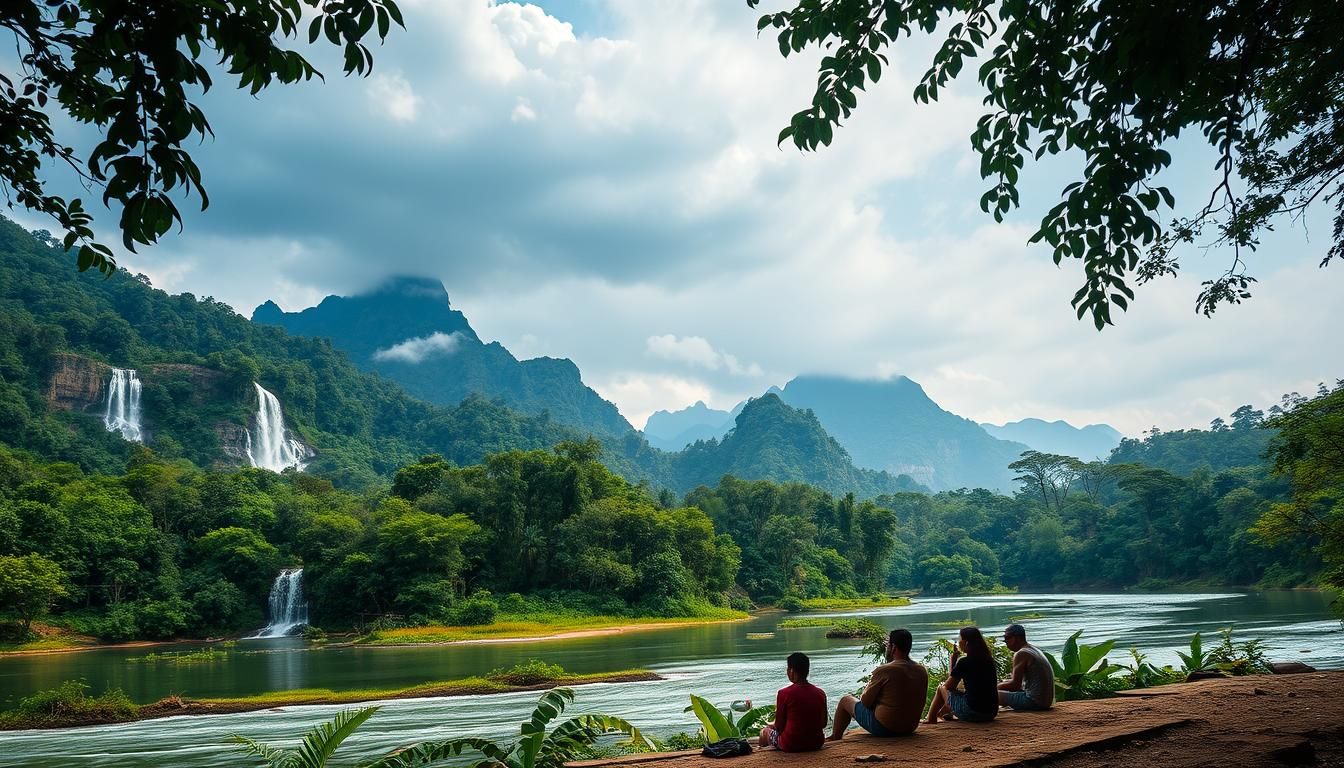Did you know that up to 40% of some regions turn a deeper green within days after the first heavy rains, transforming cliffs, valleys, and tea gardens into dramatic living landscapes?
This guide highlights the best places across India where the monsoon season makes waterfalls louder, forests mistier, and small towns feel newly alive.
From the roadside chai and low clouds at Tamhini Ghat to Ziro Valley’s rice terraces and Mawlyngot’s tea gardens, each destination offers unique scenes and calm moments by lakes or viewpoints.
Expect practical ideas for travel: toy-train rides, houseboat stays, tea and coffee tastings, monastery visits, and easy weekend escapes near Delhi. Safety and logistics tips are woven in so you can plan with confidence.
Key Takeaways
- Why go: Rains revive landscapes and reveal quieter, moodier beauty.
- Top picks range from high-altitude monasteries to coastal heritage towns.
- Activities include scenic train rides, estate tours, and wildlife walks.
- Plan timing and safety—weather can shift quickly.
- Options suit both quick weekend travel and longer adventures.
Why Travel in the Monsoon Season: Beauty, Timing, and Expectations
Travel during the wet season often means quieter trails, revived rivers, and vivid views that feel newly discovered. This is the moment when landscapes refresh, waterfalls gain voice, and morning mist shapes soft, cinematic views.
Best windows by region: Aim for early June in hill stations like Munnar, Coorg, and Darjeeling for cool mornings and gentler showers. Visit Alleppey before the heavier rains to enjoy still backwaters and houseboats. High-altitude places such as Spiti open up around June when roads become passable. Coastal spots like Goa and Pondicherry show their charm in early to mid-June.
When landscapes come alive
Mountain slopes turn emerald, tea gardens look renewed, and waterfalls swell. Expect shifting light: an overcast hour can lead to bright breaks that make views pop.
Safety first and travel tips
Slow down on wet roads and narrow ghats—Tamhini Ghat demands caution. Double-check train schedules during heavy downpours and carry offline maps for rural drives. For practical weather guidance, see this primer on understanding monsoons.
South India’s Lush Hills and Backwaters: Munnar, Coorg, and Alleppey
Rolling plantations, rushing falls, and calm houseboat cruises make this trio a perfect mix of outdoor scenes and cozy stays.

Munnar, Kerala: rolling tea gardens, cool weather, and misty viewpoints
Munnar greets June with cool days near 18°C and sweeping tea gardens that feel cinematic at dawn.
Take guided plantation trails and watch a traditional tea-processing demo. Stay in a plantation bungalow for big-window views of lush green slopes.
Coorg, Karnataka: coffee estates in bloom and monsoon waterfalls
Coorg blooms with coffee flowers and wide Western Ghats views. Visit Abbey Falls early in the season when the falls roar and the woods glow.
Choose a homestay for warm hospitality and local dishes, including robust pork curry and fresh plantation coffee.
Alleppey backwaters: serene houseboats before peak rainy season
Alleppey offers a calm window before heavy rains, with glassy canals and houseboats that come with onboard cooks.
Plan slow days: village stops, coir demos, fishing lessons, and sunset decks that stretch time.
| Spot | Highlight | Stay Style |
|---|---|---|
| Munnar | Tea gardens, misty viewpoints, 18°C days | Plantation bungalow |
| Coorg | Coffee estates, Abbey Falls, Western Ghats views | Coorg homestay |
| Alleppey | Backwater cruises, village visits, coastal cuisine | Curated houseboat |
Packing tip: bring light layers, quick-dry clothing, and mosquito repellent to stay comfortable in changing weather.
Eastern Himalayan Charm: Darjeeling and Meghalaya’s Tea-Garden Magic
The eastern Himalaya stitches together slow trains, steep tea terraces, and rain-softened forests. This region pairs classic rail nostalgia with tea culture and quiet village life.
Darjeeling by toy train
Hop the Darjeeling toy train for a slow ride through cloud forests and old stations. Wake early for a Tiger Hill sunrise; on clear mornings Kanchenjunga can appear above a sea of mist.
Take tea garden tours to watch leaf picking and learn tasting notes. These visits explain why local brews have such distinct flavors.
Mawlyngot, Meghalaya
Mawlyngot sits quieter than Cherrapunji, with soft rains drifting over tea gardens and a slow-life pace. Stays here favor small homestays and relaxed afternoons of reading and wandering.
Nongriat detour
The trail to Nongriat leads to the Double Decker Living Root Bridge. In the wet season the bridge and nearby waterfalls look almost otherworldly.
Packing tip: bring solid footwear for damp, steep trails and a light rain shell to enjoy fog-draped views.
| Spot | Highlight | Best for |
|---|---|---|
| Darjeeling | Toy train, Tiger Hill sunrise, tea tours | Culture and views |
| Mawlyngot | Quiet tea gardens, slow stays | Relaxation and walks |
| Nongriat | Double Decker Living Root Bridge, waterfalls | Nature and photography |
| Nearby | Local markets and village homestays | Meet people and taste local food |
For a deeper look at regional brews, check the tea trail to compare styles across places. Embrace the rain and enjoy the softer, misty views.
Monsoon Getaways in the High Himalaya: Spiti Valley and Tawang
When roads reopen in June, the high Himalaya unveils cliff-top gompas and stark, otherworldly valleys. These two destinations pair raw landscapes with calm spiritual sites. They reward patience and simple planning.

Spiti Valley, Himachal Pradesh: monasteries, lunar landscapes, and Chandratal
Spiti Valley in Himachal Pradesh is best reached in June when access improves and villages wake after winter. Cliff-perched monasteries, dry riverbeds, and wide skies feel almost lunar.
Make time for Chandratal Lake. Camping under star-studded nights is unforgettable, but bring warm sleeping gear and plan acclimatization days.
Tawang, Arunachal Pradesh: monasteries in the mist and mountain passes
Tawang’s Urgelling and other monasteries glow in drifting clouds. Drives over Sela Pass punctuate the route with prayer flags and snow-capped silhouettes.
The drizzle here is often fine and lingering, softening views and adding a meditative hush to the valleys below.
Altitude-ready logistics: acclimatization, gear, and limited connectivity
Plan an altitude-first itinerary: buffer days, slow ascents, hydration, and basic medication for altitude. Roads can be variable; expect slower drives and sudden weather shifts.
- Carry power banks and extra camera batteries for limited connectivity.
- Download offline maps and pack warm layers for cold nights.
- Accept a slower pace—these places reward patience and quiet adventure.
Western Ghats Road-Trip Vibes: Tamhini Ghat and Valparai
From narrow cliffside lanes to wide lake pauses, this region turns a simple drive into a nature-rich, rain-soaked escape.
Tamhini Ghat, Maharashtra
Tamhini Ghat is made for a slow, scenic road ride near Pune. Cliffside waterfalls appear without warning, and mossy rocks line the route.
Stop for roadside chai to warm your hands and try a short walk at Chande waterfall. Mulshi Lake invites calm boating when the rain is light.
Drive carefully: mist forms fast on narrow, wet stretches. Plan extra time for photos and short detours.
Valparai, Tamil Nadu
Valparai climbs through 27 hairpin bends into jungle-cloaked hills. The ascent feels wild; hornbills call and elephants sometimes cross the road.
Pause at Nallamudi Viewpoint for layered, saturated greens and moody skies. Balance driving with a jeep or guided walk in Anamalai Tiger Reserve.
Pack smart: a real rain jacket and grippy shoes let you step out and enjoy the waterfalls and forest sounds.
- Quick tips: leave extra time for viewpoint stops and wildlife sightings.
- Expect dramatic waterfalls around corners and slow-forming mist—this is a road trip that rewards getting out of the car.
- Choose stays with forest-facing windows to wake to bird calls and rolling fog.
Near-Delhi Rainy Escapes: From Bird Sanctuaries to Hill Stations
A few hours from Delhi, green trails, heritage courtyards, and calm hill stations provide a compact escape from city noise. These nearby places are easy to reach and offer a range of attractions for a day trip or overnight stay.

Okhla and Sultanpur Bird Sanctuaries
Okhla (on the Yamuna) and Sultanpur bloom after rains. Wetlands fill, migratory birds surge, and photographers find softer light for sharp shots.
Both are ideal for a relaxed day: bring binoculars, a light rain jacket, and patience for long birdwatching spells.
Neemrana Fort
Neemrana Fort, about 117 km from Delhi, feels dramatic with rain-washed courtyards. Book a heritage stay to enjoy the spa, pool time, and vintage car rides.
For thrill-seekers: ziplining here is extra fun when winds pick up and the air smells fresh.
Lansdowne and Mussoorie
Lansdowne is a quiet hill town with church spires and forest walks. It’s perfect if you want gentle trails and fewer crowds.
Mussoorie still charms with classic viewpoints and Kempty Falls. Cooler air and short woodland walks make these hill stations great for a quick recharge.
Agra and Bharatpur
The Taj Mahal grows intimate in drizzle—fewer tourists, cooler weather, and dramatic skies over polished marble. Nearby Bharatpur (Keoladeo) offers cycling through vivid trails and constant birdlife.
“Short trips near Delhi pack in wetlands, heritage, and breezy hill breaks that truly feel miles from city routines.”
- Quick tip: pick one wetland and one hill destination for a balanced short itinerary.
- Carry waterproofs, insect repellent, and a charged power bank for field days.
- Book Neemrana or a Mussoorie stay in advance for the best rooms and views.
Coastal Culture in the Rain: Goa and Pondicherry
Coastal towns wear a quieter, more intimate face when rains thread the lanes and salt air turns softer. In June, both Goa and Pondicherry trade crowded beaches for lane-by-lane discoveries. This is a great time for cultural wandering and slow food moments.
Goa off-season: spice estates, Fontainhas, and quiet sands
Goa in June moves to a locals-first rhythm. Spice plantation tours often include a fresh lunch and a walk through pepper vines and cardamom trees.
Panaji’s Latin Quarter, Fontainhas, shows off Portuguese-era hues and quiet courtyards. Wander cobbled streets and pause at a tiny chapel or a heritage home when light breaks between showers.
When conditions allow, plan a Dudhsagar day trip—but focus first on cultural rambles and heritage churches that look luminous under soft afternoon light.
Pondicherry: French Quarter, Auroville, and café culture
Pondicherry blends French facades and Tamil rhythms. Stay in a French Quarter villa and sip filter coffee in rain-friendly cafés while watching narrow lanes fill with color.
A bicycle is perfect for this town; it turns quiet streets into a relaxed route for bakeries, pottery studios, and small boutiques. Early visits to Auroville improve chances to join workshops and short programs.
- Embrace off-season prices and more time to talk with the people who live here year-round.
- Balance slow walks with heritage stays, house-long meals, and short cultural visits.
- Trade crowded sands for intimate lanes and lingering conversations that feel like the real experience of each destination.
| Spot | Highlight | Best for |
|---|---|---|
| Goa | Spice tours, Fontainhas, quiet beaches | Cultural walks and food |
| Pondicherry | French Quarter, Auroville, cafés | Slow exploration and coffee stops |
| Both | Off-season calm, friendlier prices | Relaxed trips and authentic interactions |
Ultra-Offbeat and Peaceful: Ziro Valley’s Slow Monsoon Rhythm
Ziro Valley unfolds as a slow, mist-wrapped rhythm where rice paddies and pine groves set the pace.
Rice terraces, pine forests, and Apatani culture in gentle rains
Ziro trades spectacle for serenity. Rice terraces glisten after a passing rain and small bamboo homes sit wrapped in mist.
The Apatani people shape valley life with sustainable farming and simple customs. Stop by the Apatani Cultural Museum to learn local stories and craft traditions.
Talley Valley Wildlife Sanctuary: orchids, birdsong, and quiet trails
Talley Valley blooms under the wet canopy. Orchids and shy birds appear along narrow trails.
This is a place for slow walks and mindful listening. Expect basic stays—few cafés, limited boutiques, and no loud development—so you can notice nature and the calm pace of town life.
“Come for a reset and leave with a memory that feels like a long, deep breath.”
This post highlights one of the most peaceful places to enjoy rain-soaked forests and low-key attractions in the region.
Practical Monsoon Travel Guide: Packing, Transport, and Stays
A clear checklist and flexible timing turn rainy days into memorable travel moments. This short guide covers what to pack, how to move around, and how to book stays for a smooth trip.
Packing essentials: a dependable rain jacket (not a flimsy poncho), quick-dry layers, and shoes with real grip. Waterproof cases for phone, camera, and passport keep gear safe. Add power banks, bug spray, and a compact medical kit with altitude meds and stomach soothers.
Getting around: mix short flights to save time, scenic trains like Darjeeling’s toy train for views, and weather-smart road trips that include buffer days for fog or landslides. Start early in the day and check local conditions before each leg.
Stay strategies: book view-forward rooms in plantation bungalows or heritage quarters, choose homestays for inside tips, and pick Kerala houseboats with experienced captains and cooks. Favor flexible rates and local guides who can change plans fast.
- Plan dates around windows: early June for hill stations, pre-peak for Alleppey, and early–mid June for coastal culture.
- Respect the weather, check each morning, and keep alternate routes ready.
Conclusion
End your trip by picking a place that fits your pace—whether a tea estate with wide windows, a misty hill station in Himachal Pradesh, or a slow backwater cruise. Let flexible timing turn light rains into a travel advantage and watch landscapes go lush green.
These monsoon destinations offer quiet trails, dramatic waterfalls, and local food that tastes better after a shower. Choose one or two nearby attractions, pack smart, and leave space for detours that surprise you.
Final thought: the best monsoon trips are simple: good shoes, hot tea, and time to watch the sky change. Use this travel guide as a launchpad and plan a getaway that feels like a reset.
FAQ
What are the best regions to visit during the rainy season for lush landscapes and waterfalls?
The Western Ghats (Munnar, Valparai, Tamhini Ghat), parts of South India like Coorg and Alleppey, and the Eastern Himalaya (Darjeeling, Meghalaya) come alive with mist, waterfalls, and verdant views. These regions offer dramatic scenery, accessible trails, and numerous viewpoints ideal for short escapes.
When is the ideal time to plan a trip to hill stations and high-altitude destinations?
For lower hill stations, target the early to mid rainy months when gardens and tea estates are at their greenest. High-altitude places such as Spiti and Tawang work best in the late post-monsoon window when roads reopen and skies clear. Check regional forecasts and local road updates before booking.
How should I prepare for road travel and train journeys during heavy rains?
Prioritize weather-aware planning: allow extra travel time, avoid night driving on narrow mountain roads, and keep alternate routes ready. For trains, monitor railway advisories and expect occasional delays. Carry waterproof covers for luggage and essentials, and choose flexible tickets when possible.
What clothing and gear are essential for a rainy-season trip?
Pack a lightweight waterproof jacket, quick-dry clothing, a compact umbrella, waterproof footwear with good grip, and quick-dry socks. Include a power bank, dry bags for electronics, and basic first-aid items. If you plan high-altitude travel, add warm layers and sun protection.
Are houseboats and backwater stays safe during the heavier rains?
Yes — commercial houseboats in places like Alleppey operate with safety standards and experienced crews. Still, choose licensed operators, confirm weather conditions before boarding, and opt for flexible cancellation policies in case of sudden heavy rains or water-level advisories.
Can I expect fewer crowds and better rates during the rainy season?
Many popular spots see lower tourist numbers and off-season rates, especially coastal resorts and some hill stations. This makes it easier to find view-forward rooms, plantation homestays, or guided experiences at better prices. Peak attractions may still draw local visitors on clear days.
Which culinary experiences should I try while traveling in the rains?
Seek regional specialties that suit cool, wet weather: cardamom tea in Munnar, freshly brewed Coorg coffee, hearty coastal fish curries, and warm street snacks in hill towns. Local cafés and plantation homestays often serve seasonal dishes that enhance the travel experience.
How can I plan a safe multi-day road trip through the Western Ghats or highlands?
Build buffer days into your itinerary for weather delays, choose well-maintained routes, and hire local guides if unfamiliar with mountain driving. Keep fuel, emergency contacts, and basic repair kits handy. Check live road conditions and avoid fragile stretches during heavy rainfall.
Are offbeat destinations like Ziro Valley or Talley Valley suitable during the rainy season?
Yes. These quieter valleys offer emerald rice terraces, pine forests, and fewer tourists during the rains. Trails can become slippery, so plan gentle walks, hire local guides, and ensure accommodation is confirmed in advance for a peaceful, immersive stay.
What should I consider when booking stays during the season for views and comfort?
Look for rooms with covered balconies or large windows to enjoy misty views even in drizzle. Choose properties with good drainage and positive guest reviews about service during wet weather. Prioritize hosts who offer flexible check-in/out and easy access to sheltered dining and transport.
Are there special safety tips for traveling to the Eastern Himalaya and high mountain passes?
Yes. Allow time for acclimatization, carry altitude-ready medication if needed, and travel with extra warm layers and rain protection. Mobile connectivity may be limited; share your itinerary with someone back home and consider hiring experienced local drivers for challenging passes.
How do coastal towns like Goa and Pondicherry change during the rainy period?
Coastal towns become quieter, with empty beaches, refreshed spice plantations, and lively local culture. Many restaurants and cafés remain open, and walking the Latin Quarter or visiting Auroville can be pleasant in light rain. Expect occasional closures of water activities during rough seas.
What transport options are best for weather-proof travel between regions?
Flights and well-scheduled trains offer reliable intercity options, while road travel provides scenic flexibility. For weather resilience, prefer daytime travel, choose reputable bus operators or private transfers with local knowledge, and always check real-time weather and transport advisories before departure.
